David Bengsten was a child, living in Connecticut, when he went through the ice. He was sledding, and when his sled went out on to a frozen pond, he plunged through,and his momentum carried him far enough that he had to swim back to the hole he created before he could extricate himself.
For Martin Kimbell, his first icy plunge came after decades of experience on frozen lakes and ponds. It was last winter, when he was kitewing sailing on Winnipesaukee. It was a perfect day, with lots of thick ice all over the lake, so he cheated on one of his cardinal rules of ice safety and didn’t check an area before he, on skis and propelled by a sail he holds to catch the wind, crossed over it. The ice was thin there, due to a pressure ridge, and when his skis went through, he belly-flopped into frigid water.
Now, both men repeat the mantra: No ice is safe ice.
Ice fishermen, skaters, ice boaters and kite-wing sailors see the ice forming in the Lakes Region – earlier than usual this winter – with eagerness and anticipation. Bengsten, who is now fire chief for Moultonborough, has a different reaction.
“Nervous, to be honest. We started out getting some freeze over on the ponds, then we got some snow back in December. It’s made white, milkyish ice in some areas, that’s not a good condition.”
When the ice is good, the region’s famous lakes can be a playground. But make a mistake, and catastrophe results. That was what happened two winters ago, when the season had been warm and there were broad patches of Lake Winnipesaukee that remained open into February. Then a cold snap caused them to barely freeze over in time for a heavy snowfall that came just before the annual Great Rotary Fishing Derby. Thousands of people came in for the weekend, some of whom assumed that the thick blanket of snow on top of Winnipesaukee equated to thick ice underneath. On the Saturday of that weekend, three people – two men and one teenager – died when their snowmobiles broke through thin ice.
Two of those deaths occurred in Moultonborough, and Bengsten said he and his department members think of that day often.
Dark ice preferred
“You’ve got to be very careful when you’re going out on the ice,” he said. “You really should take steps to be very careful about venturing out onto the ice. If it looks like it’s blue, blackish in color, you can go out and start checking on it. If it’s white, milky, you probably shouldn’t go out on it. If you do, you should drill a hole with an ice auger to check.”
At a minimum, Bengsten said people should look for at least four inches of dark ice.
“Anything underneath that, you should really stay off the ice,” he said.
That’s advice that Kimbell, who owns the Ashland-based Squambats Kitewing company, doesn’t always follow.
“As kitewingers, we come out for the absolute earliest ice,” he said. Three-inch-thick ice is best, he said, that’s thick enough, if it’s hard, black ice, and yet it’s thin enough that cracks haven’t formed yet. The cracks start when the ice is about four inches thick, and by five and six inches, the cracks widen to the point that they could swallow a skate blade or even the edge of a ski.
But if you’re going to flirt with such thin ice, you need to be prepared if you’re going to live to tell about it.
“When you go through the ice, you panic. That’s the whole reason you have safety gear, is to save yourself,” Kimbell said.
Kimbell doesn’t go out onto the ice without at least four pieces of safety equipment: helmet, ice picks to help claw out of the water and onto the firm ice, a life vest to keep his head from going under water, and a rope bag that he could throw to someone who has fallen in.
Kimbell also brings along Nordic skiing poles. He uses the sharp, metal point to stab at the ice and see how it responds. Cracks mushroom below the impact point, and he can see how deep the cracks form to estimate the thickness of the ice. He has enough experience to practice “ice forensics,” he calls it, reading the sheet of ice to tell how it was formed.
From the shore, a lake might look like one solid piece of ice. But it’s really several, perhaps dozens, of different sheets of ice that formed at different times and interact with one another. A trained eye can see when the surface transitions from one sheet to another, and just because one sheet of ice is thick doesn’t mean the next one will also be. On Thursday and Friday, Kimbell and a friend, Eric Morse, skated the entire length and width of Squam Lake, where they found a lot of ice that was five inches thick or thicker. But there were also instances where they found ice that was only an inch thick.
Kimbell and Morse were rejoicing in the conditions late last week, because they know that the lake can go from excellent skating to dangerous in a matter of days. In fact, that’s what is happening this weekend, with daytime high temperatures forecast to be above freezing.
Kimbell said he was going to avoid Squam this weekend in favor of Lake Wentworth in Wolfeboro, where the ice is thicker.
“You don’t want to be out on three to four inches of ice above 32 degrees. The ice structure changes, and three inches of ice can become two inches,” Kimbell said.
'Inherently unsafe'
Bristol Fire Chief Ben LaRoche said parts of Newfound Lake and sections of the Pemigewasset River are “starting to catch” but ice conditions are not yet suitable for human traffic.
“We as a practice view all ice as unsafe,” LaRoche said, “because even if it’s frozen in some areas, that doesn’t mean it’s safe in dock areas or fast-moving areas. At the end of the day, the best practice is to say ice is inherently unsafe.”
LaRoche has not seen much traffic in the areas that are starting to freeze, but he expressed concern that people might assume because it’s been cold that the ice will be thick enough for activities.
“I saw in Laconia that some kids were out with a hockey puck on the beach at Opechee,” he said. “It’s been freezing for the last week, and now it’s 35 degrees again, and warming could make it dangerous.”
The Bristol Fire Department has not had to make any ice rescues in recent years, but LaRoche said he has heard anecdotal stories of people or pets in trouble on the ice.
“I’ve heard of some incidents where people were able to self-extricate or someone nearby helped them out. It might be a four-wheeler that found a pressure ridge, but a buddy was able to pull them out — which is a good thing, because we don’t have a four-wheeler so we’d have a problem getting out there.”
He added, “Luckily, when the lake freezes, it freezes well, but I’d stay off until after the first of the year. Hopefully, people are smart enough, especially this weekend as it warms up, to stay off even if there’s a skim coat, because it doesn’t mean it’s safe.”
Center Harbor Fire Chief Leon Manville agreed that the ice is not safe yet, even though people have been out on the lake.
“I wouldn’t go out on it,” he said.
Like LaRoche, Manville said there haven’t been any ice rescues in the last couple of years.
A living thing
Kimbell recommended that people interested in going out on the ice first refer to social media pages, such as the Squambats’ Facebook page, for current conditions. But that’s still no guarantee of safety, because ice is “a living thing,” he said, and can change even over the course of a couple of hours.
If the ice does give way underneath, Bengsten said the first thing someone should do is resist the reflex to gasp and panic.
“If you do fall through, you have to stay calm, try to calm yourself down, try to keep the water from coming into your mouth,” Bensten said. Try to get your arms out onto the ice, kick your feet to propel more and more of your body onto the ice surface. Then, don’t stand up right away, because the ice might not be strong enough. “Swim your way across the ice until you’re back to where you are safe.”






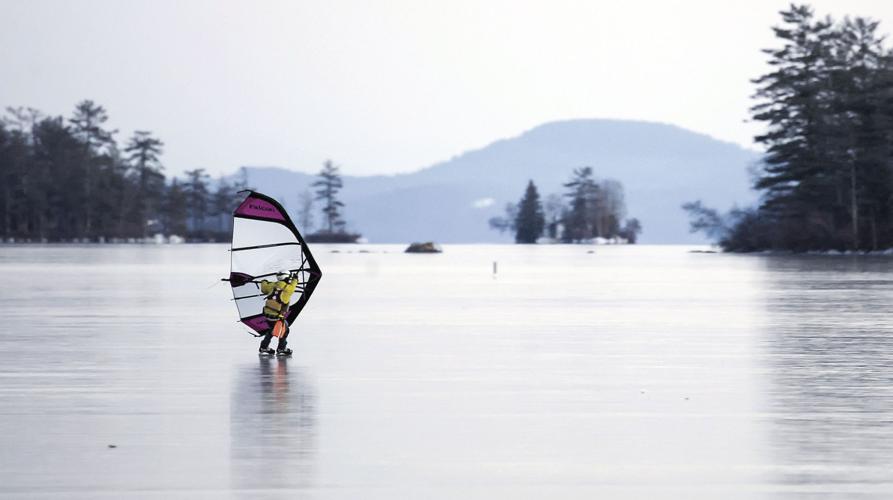
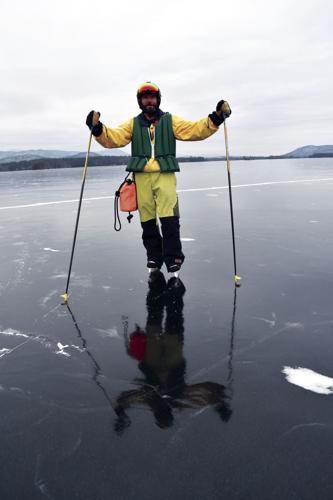
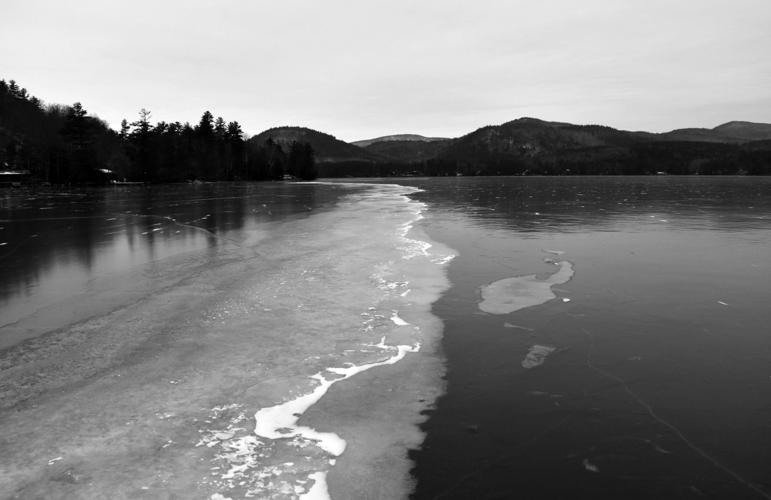

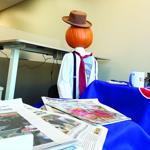




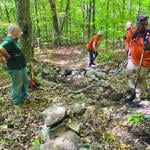




(0) comments
Welcome to the discussion.
Log In
Keep it Clean. Please avoid obscene, vulgar, lewd, racist or sexually-oriented language.
PLEASE TURN OFF YOUR CAPS LOCK.
Don't Threaten. Threats of harming another person will not be tolerated.
Be Truthful. Don't knowingly lie about anyone or anything.
Be Nice. No racism, sexism or any sort of -ism that is degrading to another person.
Be Proactive. Use the 'Report' link on each comment to let us know of abusive posts.
Share with Us. We'd love to hear eyewitness accounts, the history behind an article.